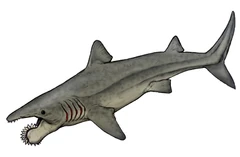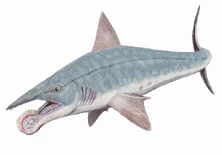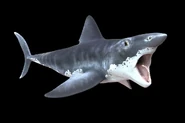| Helicoprion | |
|---|---|

| |
| An artist's illustration of Helicoprion bessonovi | |
| Scientific classification | |
| Kingdom: | Animalia |
| Phylum: | Chordata |
| Class: | Chondrichthyes |
| Subclass: | Holocephali |
| Order: | †Eugeneodontida |
| Family: | †Helicoprionidae |
| Genus: | †Helicoprion Karpinsky, 1899 |
| Type species | |
| †Helicoprion bessonovi | |
| Referred species | |
| |
Helicoprion ("Spiral Saw") was a long-lived genus of shark-like cartilaginous fish that first arose in the oceans of the late Carboniferous 280 million years ago, survived the Permian-Triassic Extinction Event, and eventually went extinct during the early Triassic some 230 million years ago.
The only fossils known are the teeth, which were arranged in a fantastic "tooth-whorl" strongly reminiscent of a circular saw. It was not until the discovery of the skull of a relative, Ornithoprion, that it was realized that the tooth-whorl was in the lower jaw. The tooth-whorl represented all of the teeth produced by that individual in the lower jaw, in that as the individual grew, with the older, smaller teeth being moved into the center of the whorl by the appearance of larger, newer teeth. Comparisons with other eugenodontids suggest that Helicoprion may have also grown up to 10–15 ft long.
The exact location of the tooth-whorl in the lower jaw is unknown. Most current reconstructions place the whorl in the front of the lower jaw; however this would create drag, making the shark a less efficient swimmer, and turbulence, alerting prey of its approach. An alternate reconstruction, created by Mary Parrish under the direction of Robert Purdy, Victor Springer and Matt Carrano for the Smithsonian, places the whorl deeper into the throat. This arrangement would be best suited for soft bodied prey.

Outdated restoration of Helicoprion
The individual teeth are serrated, and it is implied that Helicoprion was carnivorous. As there has yet to be an actual skull found, exactly how it captured or fed on its prey are subjected to a great deal of speculation. One hypothesis that it preyed on ammonites and that the teeth were specialized for the job of breaking into the ammonites' shells. Another idea was that the shark would swim into a school of fish and fling out the jaw, snagging prey on its many teeth. Notable specimens of Helicoprion have been found in eastern Idaho, northern Utah, and the far central western part of Wyoming.
In Popular Culture
Helicoprion makes an appearance in Steve Alten's 2009 Novel Meg: Hell's Aquarium.
It is featured in the Shark Week Episodes "Perfect Shark" and "Prehistoric Sharks".
It is also featured in the River Monsters episode "Prehistoric Terror", alongside several other prehistoric fish.
It can be created in both Jurassic Park Builder and Jurassic World: The Game. The model in Jurassic World: The Game shows the modern depiction of the buzzsaw, while the one in Jurassic Park Builder shows the outdated spiral saw depiction of the buzzsaw.
Helicoprion is unlocked at lv.20 in Dino pets.
Helicoprion is unlocked at lv.4 in Dino Water World.
